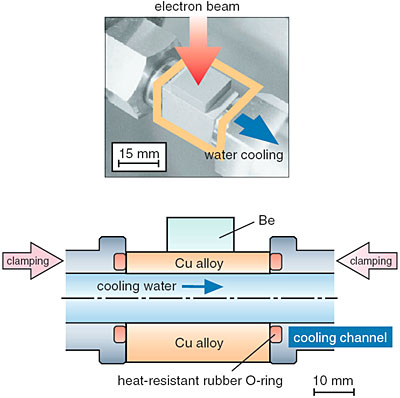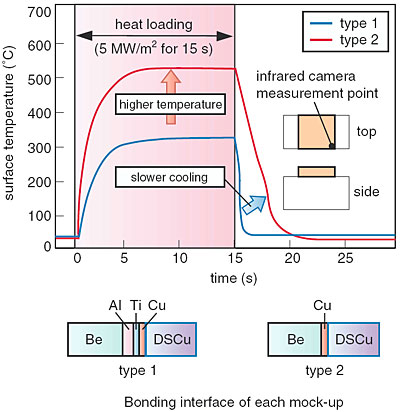The ITER first wall inside the vacuum vessel is a structural component that consists of beryllium (Be) on the surface with copper (Cu) alloy bonded to it. This component removes the heat generated in it by the plasma to the cooling water. The first wall design requirement is that it is not to be degraded under neutron irradiation and cyclic thermal loads. To obtain lifetime data of the neutron-irradiated first-wall mock-up specimens, we developed a testing apparatus that applies cyclic thermal loads to the mock-up specimens in a hot cell.
This development required applying and removing the cyclic heat loads efficiently on the compact mock-up specimens that had been neutron irradiated. Therefore, heat loading by an electron beam and the connection method to the cooling channel of the mock-up specimens were improved to facilitate remote handling. That is, small mock-up specimens, as shown in Fig. 11-5, were fabricated, and the installation of the neutron irradiated mock-up specimens in the testing apparatus was made easier by clamping with a heat-resistant rubber O-ring. Once installed, an electron beam heats the Be surface while high-pressure water provides cooling. In addition, an infrared camera was installed to monitor surface temperatures precisely.
Using this apparatus, thermal cycle tests were carried out on the mock-up specimens having Be bonded to Cu alloy (DSCu :Al2O3 content 0.5 %) as candidates for the ITER first wall. Two types of mock-up specimens were fabricated by Hot Isostatic Pressing (HIP), each with a different interlayer. The heat loading on the surface of the mock-up specimens was 5 MW/m2. The thermal cycle consisted of heating for 15 s and cooling for 15 s, and was repeated for as many as 1000 cycles. The result is shown in Fig. 11-6. The type 1 specimens maintained good heat removal performance, but the type 2 specimen showed a slow surface temperature response at the corner of the mock-up specimen during the cooling cycle. A detached joint interface was found. As mentioned above, the thermal cycle test of neutron irradiated mock-up specimens that simulates the first wall is now available and contributes data for the first wall design.
|

